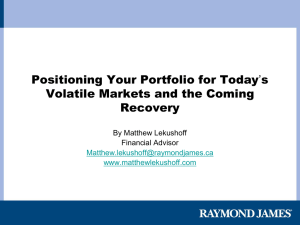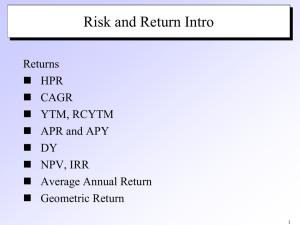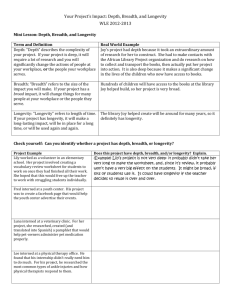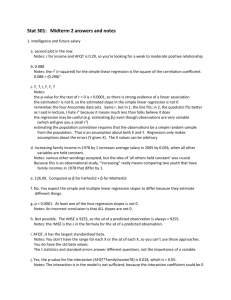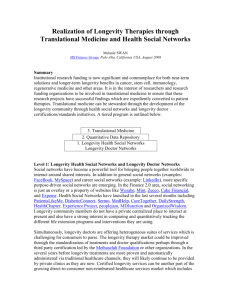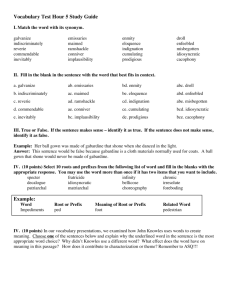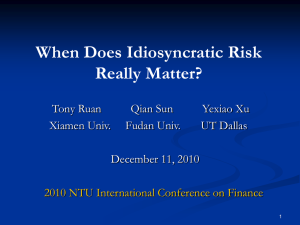Dr Michael Finke`s presentation ()
advertisement
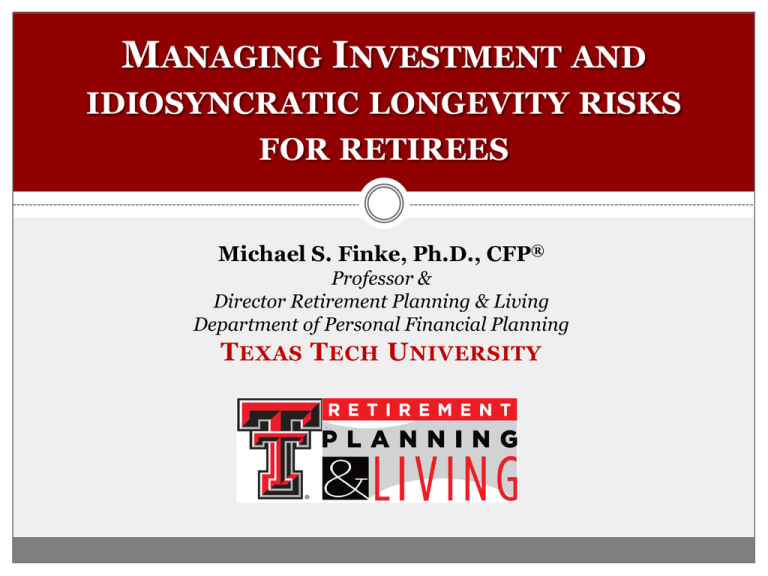
MANAGING INVESTMENT AND IDIOSYNCRATIC LONGEVITY RISKS FOR RETIREES Michael S. Finke, Ph.D., CFP® Professor & Director Retirement Planning & Living Department of Personal Financial Planning T EXAS T ECH U NIVERSITY Congratulations! You’re a pension manager! Pension Managers What do they worry most about? 1) Asset Return Risk 2) Longevity Risk Individual Pensions are Harder Asset Return Pension Manager – Pool returns across generations Advisor – One whack at the cat Longevity Risk Pension Manager – systemic increases in longevity Advisor – Idiosyncratic longevity risk Systematic Longevity Risk 24 Females 22 22 20 20 Number of years Number of years 24 18 16 18 16 14 14 12 12 10 10 1945 1950 1955 1960 1965 1970 1975 1980 1985 1990 1995 2000 2005 2010 Denmark France Japan Source: Robine, 2012 Spain Sweden UK USA Males 1950 1955 1960 1965 1970 1975 1980 1985 1990 1995 2000 2005 2010 Denmark France Japan Spain Sweden UK USA Wealthier Live Longer Source: SSA, 2008 Idiosyncratic Longevity Risk Source: Frank, 2013 Idiosyncratic Longevity Risk How do you deal with idiosyncratic risk? 1) Diversification (pool it) 2) Retain it Avoiding running out of money by spending less and accepting portfolio risk Live it up and accept greater risk of running out of money Turning Retirement Assets into Income The 4% Rule (William Bengen, 1994) Safe Withdrawal Rates (1920s - present) Figure 2.1 Maximum Sustainable Withdrawal Rates For 50/50 Asset Allocation, 30-Year Retirement Duration, Inflation Adjustments, No Fees Using SBBI Data, 1926-2010, S&P 500 and Intermediate-Term Government Bonds 9 Maximum Sustainable Withdrawal Rate 8 7 6 5 4 SAFEMAX 3 2 1 0 1925 1930 1935 1940 1945 1950 1955 1960 1965 1970 1975 1980 1985 1990 Retirement Year Philosophy of the 4% Rule Retirees have a lifestyle goal and not meeting that goal indicates failure Failure = inability to spend lifestyle goal for 30 years Portfolio risk increases likelihood of meeting spending goal Use prior returns to establish safe withdrawal rate Historical Random Returns -10.1% 3.0% 8.99% 13.7% 23.5% -38.5% 31.0% 20.3% 34.1% -1.5% 4.5% 27.3% -6.6% 26.3% 7.1% 12.4% Asset Pricing 101 pt = Εt[β * u’(ct+1)/u’(ct) * xt+1] Price at time t (now) = Expectation (now) Of β (how much we discount the future) * Marginal utility tomorrow Marginal utility today *Expected payout tomorrow What This Means Demand for Consuming Now Decreases Asset Prices Demand for Consuming in Future Increases Asset Prices What’s Affecting Asset Prices? How Much Do Global Investors Value the Future? Capital Market is Global Global Real Interest Rates Importance of 1st Decade Source: Milevsky and Abaimova, 2005 Monte Carlo Failure Rates Historical Real Returns: Stocks 8.6%, Bonds 2.6% Stock Allocation: 30% 50% 70% Failure Rates 6% 6% 6% Slightly more realistic: Stocks 5.5%, Bonds 1.75% Failure Rates 24% 24% 27% A little better than today’s rates: Stocks 6%, Bonds 0% Failure Rates 47% 33% 28% Early 2013 Rates: Stocks 4.6%, Bonds -1.4% Failure Rates 77% 57% 46% Source: Blanchett, Finke and Pfau, 2013 What if Rates Revert in 5 Years? Start out at current rates (Stocks 4.6%, Bonds -1.4%) Revert to Stocks 8.6%, Bonds 2.6% Stock Allocation: 30% Failure Rates 50% 18% 70% 18% years? 43% 32% 38% 22% What if Rates Revert after 10 Failure Rates Other Problems with the 4% Rule Source: Blanchett and Finke, 1% fee No Risk Tolerance, No Optimization Source: Finke, Pfau and Williams, 2011 Value of a Dynamic Approach 80% Withdrawal Efficiency Rate 70% Dynamic Complex Dynamic Formula RMD Method Static 60% 50% 0% Source: Blanchett, 2013 20% 40% Portfolio Equity Allocation 60% 80% Illustration of Dynamic Real Withdrawal Amount Figure 6 Individual Simulated Paths for Spending and Wealth For a Couple with $100,000 Wealth and a 60% Stock Allocation Simulations Based on Historical Averages $12,000 $11,000 $10,000 $9,000 $8,000 $7,000 $6,000 $5,000 $4,000 $3,000 $2,000 $1,000 $0 65 Constant Inflation-Adjusted Spending Guyton Rules Blanchett Rule 70 75 80 85 Age 90 95 100 105 70 75 80 85 Age 90 95 100 105 $200,000 Real Remaining Wealth $175,000 $150,000 $125,000 $100,000 $75,000 $50,000 $25,000 $0 65 Source: Pfau, 2013 Assumes Historical Equity Premium S&P Dividend Yields What Does Current P/E Imply? Source: Asness, 2012 Requires Managing Assets in Old Age Literacy and Confidence 90 Financial Literacy Confidence 80 70 60 50 40 30 20 10 0 60 65 70 75 80 85 A Better Approach Prioritize spending categories (basic needs, discretionary expenses, legacy) Employ risk when a retiree is willing to accept possibility of a loss Deal efficiently with idiosyncratic risk Simplicity - make sure real people can handle it, use research to create defaults Be realistic about future asset returns QUESTIONS/COMMENTS Michael S. Finke, Ph.D., CFP® Professor, Ph.D. Program Director Director Retirement Planning and Living Department of Personal Financial Planning T EXAS T ECH U NIVERSITY Michael.Finke@ttu.edu

